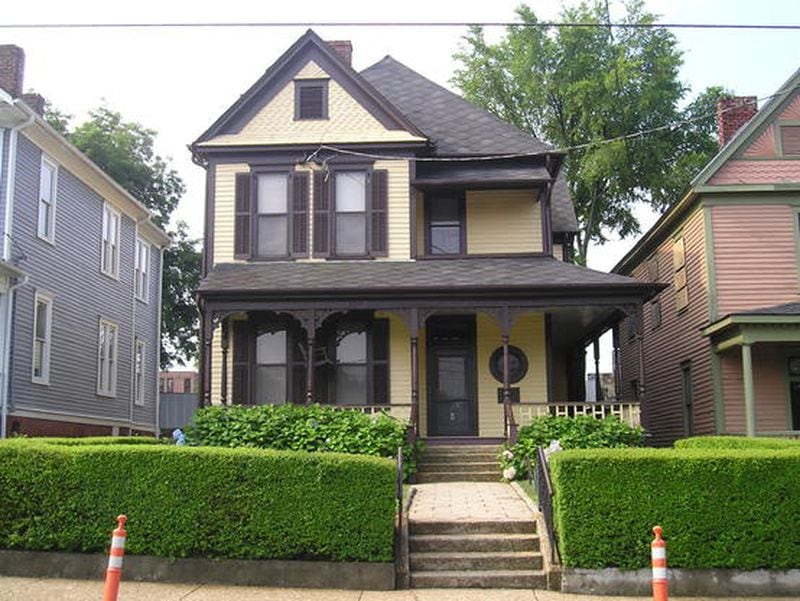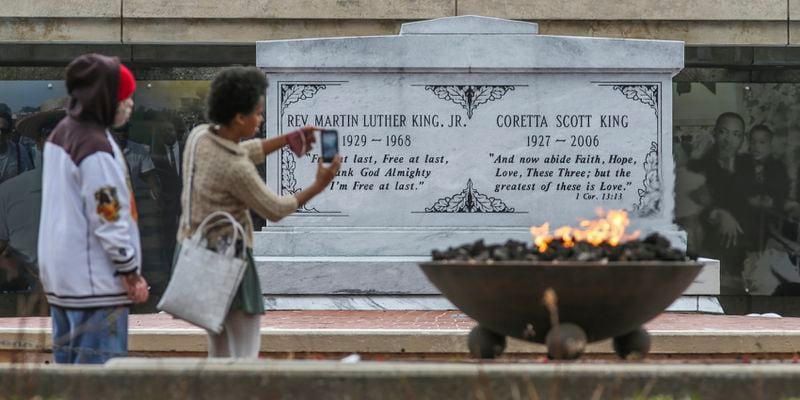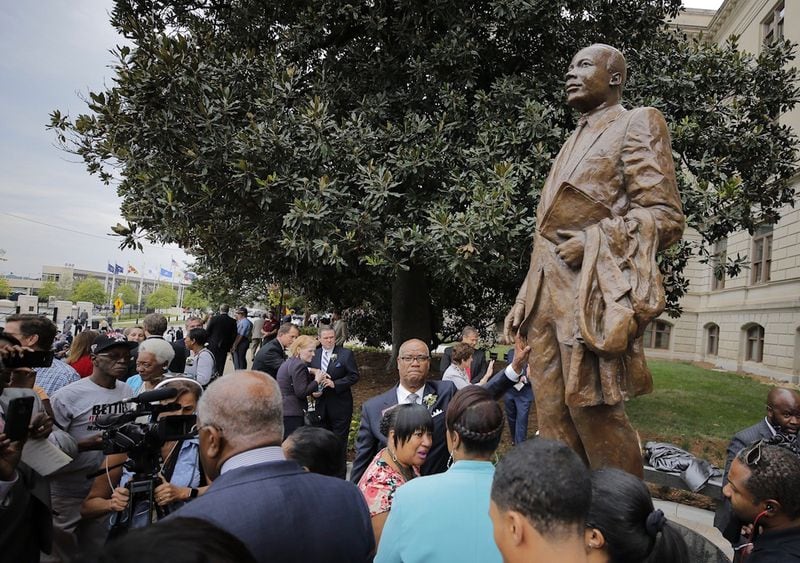Martin Luther King Jr. National Historic Park
The Visitor Center, Historic Ebenezer Baptist Church, and Freedom Hall open 9 a.m.-5 p.m. daily (until 6 p.m. in summer), except Thanksgiving, Christmas and New Year's Day. Free. Visitor Center, 450 Auburn Ave. N.E. (Free parking behind it at 417 John Wesley Dobbs Ave. N.E.) 404-331-5190, www.nps.gov/malu.
The Birth Home is open for ranger-led tours from 10 a.m.-4 p.m. daily. Fire Station No. 6 is open from 9 a.m.-5 p.m. when volunteers are available. The expanded park includes the building that housed SCLC offices.
Birth home tours: Temporarily closed
Normally open as part of the only guided tours at the historic site, the birth home is closed for at least two years for a major overhaul that began in late 2023.
Driving the civil rights movement, the Rev. Martin Luther King Jr. made a huge impact in cities including Montgomery and Birmingham, Chicago and Washington. But one city above all others made a monumental impact on him, his hometown of Atlanta, and that is the story that the Martin Luther King Jr. National Historic Site attempts to tell more than 700,000 visitors annually.
Guide to Martin Luther King Jr. National Historic Site
National Park Service Visitor Center
At first, sound bleed between the video-driven six mini exhibits on the civil rights leader’s life is disconcerting. Visitors stand inside small viewing areas, surrounded by photos, protest signs and other artifacts, and crane their necks at video monitors that are never silent and seem to compete with one another for attention.
But the viewing — everything from historian Clayborne Carson discussing King’s Sweet Auburn upbringing to excerpts from the minister’s final sermon, “The Drum Major Instinct” — is captivating. And ultimately the experience seems like the ’60s era itself: lots of heady information coming at you all at once from multiple directions.
Amid these often-crowded galleries, the “Freedom Road” exhibit is a figural tribute to the everyday people who became the movement’s “foot soldiers.”
In an adjoining space, the D.R.E.A.M. Gallery is dominated by the center’s most significant artifact, the timeworn funeral wagon that mules Belle and Ada pulled on April 9, 1968, from Ebenezer Baptist to Morehouse College, King’s alma mater, for his final funeral service.
Tickets and fees: There is no entrance fee.
Much of the furniture and furnishings inside this cozy, yellow, two-story clapboard house with dark brown trim, purchased by King’s grandfather in 1909 for $3,500, is original. But not the Barbie doll found in one of the downstairs bedrooms. That’s because Martin and his younger brother A.D. were extremely boyish boys who enjoyed dismembering older sister Christine’s dolls, sometimes using their heads as baseballs.
Historic site lead ranger Marty Smith said he likes to put the emphasis in his tours of the home on “how the family supported each other, lived and worked closely with each other. Dr. King, sometimes we put him on this high pedestal and don’t realize he was an ordinary man who just did extraordinary things, and how he came from that great family structure.”
Visitors sense that intimacy throughout the six-bedroom, two-story home, in the formal front parlor where the boys took piano lessons to the den where “Daddy” King ruled as the Chinese checkers champ, to the dining room where the family, including his maternal grandparents, broke bread every night and the children were encouraged to participate in discussion of current events.
Upstairs, in his parents’ bedroom, the mantel clock is permanently set to noon, the exact time Martin was born there.
“They say Daddy King was so happy when he learned that his second child was a boy that he jumped and touched the ceiling,” Smith recounted, noting that the house’s ceilings are 11 feet and King’s dad was 5-foot-6. “Either that’s a tall tale or he was a pretty good jumper.”
Fees and tickets: Temporarily closed for up to two years as of November 2023.
Ebenezer Baptist Church, Heritage Sanctuary
Everything from electrical systems to stained-glass windows was replaced or painstakingly revived when this Gothic Revival-designed church, constructed between 1914 and 1922, was closed for an $8 million restoration. The project spanned four years and brought the interior back to its appearance from the 1960s, when King was co-pastor along with his father.
What’s striking about the experience of visiting the sanctuary, which reopened in 2011, is how little interpretation the Park Service provides, either in writing or verbally. Stepping inside from under the historic blue sign with white neon letters, visitors are ushered upstairs into the sacred space, warmly painted in a peachy coral and carpeted in regal red.
Instead of hearing a ranger talk or reading informational panels, guests slide into one of the old wooden pews and listen to a tape of King preaching or of gospel singing.
Superintendent Forte said the Park Service felt visitors would appreciate having a quiet visit with ample opportunity to reflect on the life of King, who was baptized here at age 5 and tried his first sermon here as a teenager. This also is where he delivered his last one, “Drum Major Instinct,” on Feb. 4, 1968, two months before he was killed in Memphis, Tenn.
“One reason people come to site is for the experience of walking in Martin Luther King Jr.’s footsteps,” Forte said, “not necessarily to hear all the facts.”
Credit: JOHN SPINK / AJC
Credit: JOHN SPINK / AJC
A cramped gallery space upstairs in Freedom Hall boasts some powerhouse artifacts from King’s life, from his 1964 Nobel Peace Prize to his pastoral robe and sash to the small suitcase/briefcase that the civil rights leader, who traveled light, carried wherever the movement took him. The cologne may have dried out of the Aramis bottles on view, but the cuff links and tie tacks in a small jewelry case twinkle still.
The center, not the Park Service, is responsible for this exhibit. Minimal and sometimes missing accompanying text misses the opportunity to completely underline the significance of what visitors are viewing. In adjoining biographical exhibits on Mahatma Gandhi and Rosa Parks, the almost complete lack of context is dismaying.
Outside, the King tombs and the adjoining Eternal Flame, symbolizing the couple’s commitment to their community, are where tourists’ phone cameras come out and many a tear is shed.
This red-brick firehouse built in 1894 in the Romanesque Revival style served the city for nearly a century.
Inside, there is information on Atlanta firefighting history. Younger visitors will be excited about the restored 1927 American LaFrance fire engine on view.
By the time King would have visited here as a child, Jim Crow had forced African-Americans out of the field. “Growing up to be a fireman,” a text panel points out, “was not a dream a black child was supposed to have.”
Back story: What will you find at the Martin Luther King Jr. National Historic Site and historic Auburn Avenue?
As the nation observes the King national holiday in January, thousands are expected to flock over the long weekend to the 35-acre historic site that borders the eastern edge of downtown Atlanta and stands beside the city's first successful African-American business district. It's one of Atlanta's busiest tourist draws 365 days a year.
King was born in the home of his maternal grandparents at 501 Auburn Ave. on Jan. 15, 1929, and while Atlanta has changed and grown dramatically in virtually every direction beyond his old neighborhood, it, remarkably, has remained much the same as it was during the 12 years he grew up here.
The National Park Service established the historic site in 1980 to preserve the places where King was born, lived, worked, worshipped and is buried. Site superintendent Judy Forte says the historic district is singular among Park Service properties in its ability to show and tell such a complete story of one important American life.
“Somewhere where an individual was born, where he lived, where he worked and where he’s buried, it doesn’t exist other than here,” Forte said. “You may have a birth home, you may have a church, you may have a community, but to have all of that, that’s very unique and special to this site.”
The site’s virtually unchanged components included the King Birth Home, where Martin was born in his parents’ upstairs bedroom, which has been restored and furnished to match its appearance during his childhood years of the 1930s and early ‘40s. The site also includes Ebenezer Baptist Church’s Heritage Sanctuary, built in 1914-22 and restored and reopened in 2011 to recapture the era during which King attended services and followed his father and maternal grandfather, the Rev. Martin Luther “Daddy” King Sr. and the Rev. A.D. Williams, to its pulpit.
The National Park Service Visitor Center is the essential starting place that orients visitors to the home and church that were such substantial forces in shaping the boy who would become a societal leader, but also to the district's other important attractions. Most significant among them is the King Center, directly across Auburn Avenue, the institution carved by King's widow Coretta Scott King to carry on his work and the place that houses the tombs of King and his wife amid its Reflecting Pool.
Through video, photographs and artifacts, six connected Visitor Center mini exhibits sketch out King’s career. But Forte said the Park Service made an early determination: “There’s no way we can tell all of that story. It’s a big story to tell, it’s an important story to tell and each city involved has their story to tell.”
As Atlanta’s role in the movement was “minor in comparison to some of the other cities,” the superintendent said, the tale that the Park Service tells in detail is about King’s and his community’s life from his 1929 birth until 1941, when the family moved nearby to Boulevard. Adding texture to the telling are 40 shotgun houses and bungalows that the Park Service restored to period condition. Three-quarters of them are rented as housing, another unique aspect of the King Historic Site, and a quarter are used for park offices and a well-stocked bookstore.
Credit: Bob Andres
Credit: Bob Andres
In an exhibit inside the 1894 Fire Station No. 6, another of the historic site's restored gems, visitors can find information on how the "Sweet Auburn" neighborhood prospered in the harsh wake of the Atlanta's 1906 race riots that strengthened the grip of Jim Crow restrictions and segregation. By 1930, not long after King's birth, the district boasted 121 black-owned businesses and offices for 39 African-American professionals.
“This was the world Martin Luther King experienced growing up on Auburn Avenue,” reads one of the text panels, “a street rich with examples of black success and achievement, but hemmed in and diminished by Jim Crow segregation and racial discrimination.”
About the Author








